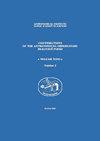太阳氢Lyα线对电离层D区GNSS信号延迟的影响
IF 0.2
4区 物理与天体物理
Q4 ASTRONOMY & ASTROPHYSICS
Contributions of the Astronomical Observatory Skalnate Pleso
Pub Date : 2022-12-01
DOI:10.31577/caosp.2022.52.3.116
引用次数: 0
摘要
最近的研究表明,在太阳X射线飞行期间发出的强烈X射线辐射中,电离层D区对卫星信号传播的影响不容忽视。在本文中,我们研究了太阳氢Lyα辐射的变化对全球导航卫星系统(GNSS)信号传播的影响,这种变化表现为D区电子密度的变化,以及该区总电子含量的变化。我们考虑一个太阳周期和一年中的变化,用平滑的每日太阳黑子数和一年的哪一天来表示。所获得的结果表明,对于在太阳周期最大值附近的时间段内由单个接收器记录的单个信号进行定位,D区对这些信号的影响是不可忽略的。本文章由计算机程序翻译,如有差异,请以英文原文为准。
Influence of the solar hydrogen Lyα line on the GNSS signal delay in the ionospheric D-region
. Recent research indicates that the influence of the ionospheric D-region on the propagation of satellite signals cannot be ignored during the intense X-radiation emitted during solar X-ray flares. In this paper, we investigate the influence of changes in the solar hydrogen Ly α radiation, which is manifested in variations of the D-region electron density and, consequently, the total electron content in this region, on the propagation of the Global Navigation Satellite System (GNSS) signals. We consider changes during a solar cycle and year, represented by the smoothed daily sunspot number and the day of year. The obtained results indicate that the influence of the D-region on these signals is not negligible for positioning with a single signal recorded by a single receiver during the period around the maximum of a solar cycle.
求助全文
通过发布文献求助,成功后即可免费获取论文全文。
去求助
来源期刊
CiteScore
1.10
自引率
20.00%
发文量
4
审稿时长
>12 weeks
期刊介绍:
Contributions of the Astronomical Observatory Skalnate Pleso" (CAOSP) is published by the Astronomical Institute of the Slovak Academy of Sciences (SAS). The journal publishes new results of astronomical and astrophysical research, preferentially covering the fields of Interplanetary Matter, Stellar Astrophysics and Solar Physics. We publish regular papers, expert comments and review contributions.

 求助内容:
求助内容: 应助结果提醒方式:
应助结果提醒方式:


